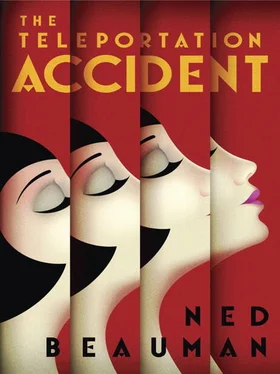Ned Beauman
THE TELEPORTATION ACCIDENT
I hate politics and belief in politics, because it makes men arrogant, doctrinaire, obstinate, and inhuman.
Thomas Mann,
Reflections of a Nonpolitical Man
…all I had to do was go down into the subway. It was like fishing down there. Go down into the subway and come up with a girl.
Philip Roth,
The Human Stain
When you knock a bowl of sugar on to your host’s carpet, it is a parody of the avalanche that killed his mother and father, just as the duck’s beak that your new girlfriend’s lips form when she attempts a seductive pout is a quotation of the quacking noise your last girlfriend made during sex. When the telephone rings in the night because a stranger has given a wrong extension to the operator, it is a homage to the inadvertent substitution of telegrams that terminated your adulterous cousin’s marriage, just as the resonant alcove between the counterpoised struts of your new girlfriend’s clavicle is a rebuttal to the apparent beauty of your last girlfriend’s fleshier décolletage. Or this is how it seemed to Egon Loeser, anyway, because the two subjects most hostile to his sense of a man’s life as an essentially steady, comprehensible and Newtonian-mechanical undertaking were accidents and women. And it sometimes seemed as if the only way to prevent that dread pair from toppling him all the way over into derangement was to treat them not as prodigies but rather as texts to be studied. Hence the principle: accidents, like women, allude. These allusions are no less witty or astute for being unconscious; indeed, they are more so, which is one reason why it’s probably a mistake to construct them deliberately. The other reason is that everyone might conclude you’re a total prick.
And that was the final worry to flutter through Egon Loeser’s mind before he pulled the lever on his Teleportation Device one morning in April 1931. If it went wrong, they would all say: for what possible reason did you name your experimental stagecraft prototype after the most calamitous experimental stagecraft prototype in the history of theatre? Why make that allusion? Why hitch those two horses together? Paint the devil on the wall and the devil will come, as every child knows. Or, to sieve the German idiom down to an English one, don’t tempt fate. But Loeser was so unsuperstitious he was superstitious about it. He’d once got up on the stage of the Allien Theatre half an hour before a performance to shout ‘Macbeth!’ until he was hoarse. And one of his father’s long-standing psychiatric patients had been an American financier who named his yacht Titanic , his daughters Goneril and Regan, and his company Roman Empire Holdings in the same spirit. So he couldn’t credit the English idiom’s characterisation of fate as something like a hack playwright who never missed a chance to work in an ironic pratfall, any more than he could credit the German idiom’s characterisation of the devil as something like a preening actor who checked every gossip column in every newspaper every morning for a mention of himself (although perhaps God was like that). Accidents allude, but they don’t ape. Naming one thing after another cannot, logically, increase the chances of the new thing turning out like the old thing. But if the test today went straight to ruin, people would still say he shouldn’t have called it the Teleportation Device.
What choice did he have, though? This machine was primarily intended for use in a play about the life of Adriano Lavicini, the greatest stage designer of the seventeenth century. And the climax of the play portrayed the ghastly failure of Lavicini’s Extraordinary Mechanism for the Almost Instantaneous Transport of Persons from Place to Place, better known in modern discourse as the Teleportation Device. Since Egon Loeser was, in his own opinion, Lavicini’s closest modern counterpart, and since this new Teleportation Device was his finest innovation just as the old Teleportation Device had been Lavicini’s, then to stifle the parallel between the two would have been even more perverse than to let it breathe.
Anyway, Lavicini himself had painted the devil on the wall with far bolder strokes than Loeser possibly could. Back in 1679, the Teleportation Device wasn’t allowed a test run. Like a siege weapon, it had been constructed in total secrecy. No stagehand had seen more than a single jigsaw piece of the plans. Even Auguste de Gorge, the dictatorial owner of the Théâtre des Encornets, had not been permitted a peek, and even at the final dress rehearsal of Montand’s new ballet The Lizard Prince the machine had not yet been in operation, so neither the dancers nor their choreographer had any idea what to expect on opening night. But Lavicini insisted that the operations of the Teleportation Device were so precise that it didn’t matter, and the essential thing was that no rumours about the nature of the machine should escape.
The comparison to a siege weapon was especially apt here, Loeser always thought, because in the seventeenth century the struggle for supremacy between the great theatres and opera houses of Christendom resembled nothing so much as an arms race. For the ruling family of any major Italian city it would have been a political catastrophe to fall behind, and even within Paris the competition was fierce, which was why a set designer like Lavicini, who had in fact once held a job at the Venetian Arsenal, could expect to be bound as tightly by his contract of employment as the average twentieth-century germ-warfare scientist. (His salary, naturally, was large enough to make up for it.) This was an age in which the audience expected sphinxes pulling chariots, gods dancing in the air, lions transforming into girls, comets destroying city walls — all the really good stuff, of course, towards the middle of the play, because during the first act you would still be on the way to the theatre and by the fifth act you would already be doffing your hat to a platter of oysters. A typical published libretto might proudly list all nineteen contraptions that were to be set into motion during a performance, but neglect to mention the composer. Impresarios were bankrupted in their dozens, and enlightened critics complained that genuine dramatic values had been surrendered to this obsession with ‘the marvellous’, continuing a debate about the overuse of special effects that had begun with the Reformation and would presumably last until Hollywood fell into the San Andreas fault.
So Lavicini’s employer could forgive him for wanting to keep the Teleportation Device a total secret. Still, even de Gorge, who had once strangled a man while dictating a love letter, must have felt a little nervous as the entire bejewelled elite of Paris, including, last of all, Louis XIV and his queen, arrived at the Théâtre des Encornets for the première of The Lizard Prince , greeting each other with hand-kissings so formalised and ostentatious they were like miniature ballets in themselves. For the thousandth time he must have reminded himself of what his mentor Lunaire had once taught him: as an impresario, you shouldn’t flatter yourself that you were really anything to do with the show. You couldn’t conjure a hit. Your job was just to sell tickets. And if you had done that to the best of your ability, said Lunaire, then the only thing left to pray for was that nobody in the audience arrived with a dog bigger than a child or a pistol bigger than an upholstery hammer. But all this without even rehearsing the new machine — that was painting the devil on the wall.
Loeser’s Teleportation Device, by contrast, was about to be demonstrated at the little Allien Theatre in Berlin in front of only two other people: Adolf Klugweil, the putative star of
Читать дальше












